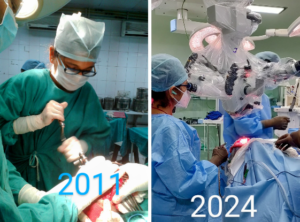Dr. Vishakha Karpe
MBBS, DNB(Surg), MCH (neurosurgery), MRCS (UK),
Fellowship in neuroendoscopic surgery.

Abnormal head shape in babies can be because of either due to positional Plagiocephaly or craniosynostosis. Positional Plagiocephaly also known as Flat Head Syndrome, is caused by external pressure on one area of the skull, often from prolonged lying in the same position. It results in flattening on one side or the back of the head, malaligned ears, and a slight forehead bulge.
What is craniosynostosis?
Craniosynostosis is a birth defect where the sutures in a baby’s skull fuse too early. This results in a misshapen head shape. Physiologically, the cranial sutures maintain flexibility during infancy, facilitating brain growth and development. The condition can involve one or multiple suture craniosynostosis. It can be caused by certain genetic syndromes. Surgical intervention is typically required to correct the cranial deformity and facilitate optimal brain growth. Early diagnosis and treatment are crucial for a baby’s brain to grow and develop adequately. Most children with craniosynostosis develop normally in terms of motor milestones but might have thinking and learning disabilities. Additionally, surgery typically results in excellent improvements to the shape of the head. Early identification and timely management are vital for preventing complications and ensuring the best possible outcomes. Craniosynostosis can also cause increased pressure on the brain. It might alter the skull and facial bones’ symmetrical appearance.
Types of Craniosynostosis.
Craniosynostosis is a condition involving the fusion of a single or multiple cranial sutures. Some complex forms are often linked to genetic syndromes. The term used depends on the affected sutures.
Craniosynostosis is a manageable condition when diagnosed and treated early. Parents should closely monitor their baby’s head shape and seek medical advice if abnormalities are noticed.
- Sagittal (scaphocephaly)
Scaphocephaly is a condition characterized by a long and narrow head, prominent forehead and back, and narrow skull. If not positional , It is caused by premature closure of sagittal suture.
Symptoms to worry about : abnormal head shape , developmental delay and visual disturbances .
It can cause signs of increased intracranial pressure, such as persistent irritability, vomiting, and developmental delays. Developmental concerns may include delays in motor or cognitive milestones, poor feeding, or failure to thrive. Narrow skull with a prominent ridge along the sagittal suture warrants evaluationScaphocephaly can be diagnosed through physical examination and imaging. Patient has to be referred to a pediatric neurosurgeon. Early evaluation is crucial. Early surgical intervention typically resolves scaphocephaly, ensuring normal brain growth and improved cosmetic appearance. It is essential to monitor the baby’s head shape and developmental milestones in the follow up .
- Coronal Craniosynostosis (plagiocephaly/brachycephaly)
Coronal craniosynostosis occurs when coronal sutures fuse prematurely, either unilaterally or bilaterally, across the skull, and early detection is crucial to prevent complications.
Signs to worry about:
Abnormal head shape can be categorized into unilateral and bilateral coronal synostosis, resulting in a flattened forehead, raised eyebrows, and a deviated nose. A bilateral synapse results in a broad, flat forehead, often with a raised ridge along the coronal suture. Asymmetry in facial features is also present. Signs of increased intracranial pressure include irritability, vomiting, and tense fontanelle. Developmental concerns include delays in milestones, poor feeding or growth, and visual problems like strabismus or difficulty tracking objects. Diagnosis and treatment involve physical examination, imaging, and vision testing. Genetic testing may be conducted to identify associated conditions. Early intervention improves cosmetic and functional outcomes, and complications like developmental delays, vision problems, or increased intracranial pressure require urgent attention.
- Metopic (trigonocephaly)
Metopic craniosynostosis is a condition where the metopic suture, which connects the nose to the head, closes prematurely, causing a triangular-shaped forehead called trigonocephaly, which can cause developmental or functional issues.
Signs to worry about
Metopic craniosynostosis is a condition characterized by abnormal head shape, developmental delays, and visual problems. Symptoms include developmental delays , speech delay, cognitive and learning disabilities; persistent vomiting, irritability, and lethargy. A physical examination is necessary to assess the head shape, suture ridges, eye spacing, and developmental milestones. Imaging studies, such as CT scans confirm the closure of the metopic suture and assess skull and brain growth. Genetic testing may be conducted to identify associated conditions. Early diagnosis and treatment are crucial for optimal outcomes, with most children achieving normal brain growth, good cosmetic outcomes, and developmental progress.
- Lambdoid (posterior plagiocaphaly)
Lambdoid craniosynostosis is a rare form of craniosynostosis where the lambdoid suture at the back of the skull fuses prematurely, leading to abnormal head shape and severe complications. It’s crucial to differentiate it from positional plagiocephaly.
Signs to worry about
Lambdoid craniosynostosis is a condition characterized by abnormal head shape, asymmetry at the back, visible ridges along the lambdoid suture, skewed skull base, and compensatory bulging. This asymmetry does not improve with repositioning or time, and signs of increased intracranial pressure include persistent irritability, inconsolable crying, vomiting, lethargy, and tense soft spots. Developmental delays are common, causing delays in motor or cognitive milestones. A physical examination is necessary to evaluate head shape, ear alignment, and suture ridges. Early diagnosis improves outcomes and prevents complications. Children with lambdoid craniosynostosis typically achieve good cosmetic and developmental outcomes with appropriate treatment.

Other causes of abnormal head shapes in babies :
- The birth process causes pressure during delivery, causing temporary head moulding, resulting in a cone-shaped or uneven appearance, typically resolving within a few days to weeks.
- Torticollis is a congenital condition characterized by tight or shortened neck muscles, causing a baby’s head to turn one side, flattening on one part of the skull, and difficulty moving the head in the opposite direction.
- Premature babies’ soft skull bones are more susceptible to external pressure, leading to flattening or unevenness due to prolonged time in one position.
- Hydrocephalus is a condition characterized by excessive cerebrospinal fluid in the brain, resulting in head enlargement, uneven growth, and signs of increased intracranial pressure.
- Genetic conditions like Apert, Crouzon, or Pfeiffer syndromes cause skull and facial abnormalities, often linked to craniosynostosis.
- Accidental skull trauma during or after birth can cause localized swelling or deformity, accompanied by bruising or discomfort.
Diagnosis and prognosis
Diagnosis
A medical history and physical examination are essential for diagnosing craniosynostosis. These include head shape assessment, fontanelle check, developmental milestones, imaging studies like CT scans, and MRIs, which help visualize prematurely fused sutures, confirm specific sutures, and detect brain or soft tissue concerns. Genetic testing is recommended for syndromic craniosynostosis, identifying associated mutations or syndromes. Differential diagnosis differentiates craniosynostosis from positional plagiocephaly, caused by external pressure and not involving fused sutures. Genetic testing can help identify associated mutations or syndromes.

Prognosis
Positional plagiocephaly has good prognosis and gets corrected by positional changes helmet therapy
The prognosis of craniosynostosis depends on its type and severity, whether it is isolated or part of a genetic syndrome, and the timing and success of treatment. Isolated craniosynostosis is generally excellent with early intervention, and treatment typically resolves cosmetic and functional issues. However, delayed treatment can lead to increased intracranial pressure. Syndromic craniosynostosis is more complex and may require multiple surgeries and long-term follow-up with specialists. With timely treatment, long-term outcomes include improved cosmetic results, normal brain development, and normal developmental milestones. Delayed treatment increases the risk of complications like vision problems, developmental delays, and persistent head shape deformities.
A baby’s uneven head shape can be due to various factors, including normal development or medical conditions. Understanding these causes is crucial for intervention. Craniosynostosis is a manageable condition when diagnosed and treated early. Parents should closely monitor their baby’s head shape and seek medical advice if abnormalities are noticed.
About Dr Vishakha :
Dr Vishakha Basavraj Karpe is a highly skilled senior consultant at Rainbow Children’s Hospital in Banjara Hills and Hydernagar Hyderabad. She is known for her comprehensive care approach and is one of the few dedicated leading paediatric neurosurgeons in the city and India with over ten years of extensive experience in pediatric neurosurgery. Her expertise includes treating hydrocephalus, spinal dysraphism, craniosynostosis, paediatric brain infections, brain and spine tumours and stroke surgery.
She has a special interest in craniosynostosis surgery, which is done only in very few centres in India.
Proficiency of Dr Vishakha:
-
-
Hydrocephalus (increased fluid in the brain): The procedure involves an endoscopic third ventriculostomy and CSF diversion (VP shunt) to treat complexx hydrocephalus.
- Craniosynostosis (abnormal head shape due to untimely cranial sutures fusion) surgeries: Helmet therapy is a technique that is used in both endoscopic and open surgery.
-
- Spinal dysraphisms(Spina Bifida)- (spinal abnormalities present by birth) – surgical repair
- Encepahaocles repair surgery.
-
- Vascular conditions and stroke surgeries: revascularization surgeries for moya moya disease.
- Pediatric brain and spine tumour surgeries.
-
- Pediatric brain and spine infection surgeries: Endoscopic and open surgeries for brain and spine infections.
- Pediatric traumatic brain and spinal injury.
- Antenatal counselling for congenital fatal neurosurgical conditions.





